Revision Workshop in Rome, 16-17 June, 2005
Japan
Our Positions on issues surrounding the basket revisions
We would like to express our appreciation to the OECD for its many years of providing price comparison on telecommunication services around the world. We are also grateful for being invited today to this workshop, in association with Teligen, on price performance basket revisions.
An environmental change is rapidly advanced now in the telecommunications market. In view of the movements from existing PSTN services to mobile-phone services and IP telephony services and from dial-up Internet connection to broadband Internet connection services, a fee system changes from the usage based rate system to the monthly sum fixed charge system, from the rate system according to the distance to the flat rate available whole country and all parts of the world, and from tariff based charge to the charge setting by the negotiated transaction. As a result, a simple comparison of the charges is difficult. It is important to review the object and the content of the price basket boldly according to the current state of the market to do the charge investigation by OECD usefully under such a situation.
In this document, we will first present the market-condition and service-structure changes underway in Japan. Then, based on these transformations, we will detail our positions on issues surrounding the basket revisions.
1 Current Conditions in Japan
1.1 Decline in Demand for Fixed-line Phones
1.1.1 The number of fixed telephone subscribers in Japan has dropped off gradually since a peak in 1997. Meanwhile, the number of subscribers to mobile communication services overtook that of fixed telephone services in 2000. The gap in subscriber numbers continues to widen.Figure 1: Transitions in the Subscriber Numbers of Telephone
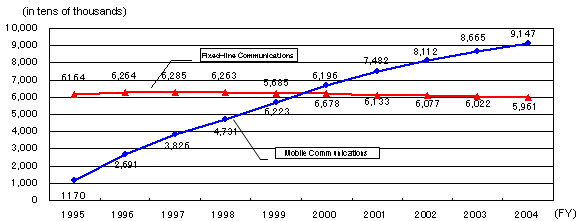
Source: Transitions in Numbers of Subscribers to Telecommunication Services - 2004 Year-end, Ministry of Internal Affairs and Communications
1.1.2 Furthermore, in terms of fixed-line phone traffic, the numbers of calls have declined to 80 percent of their record peak and call times have plummeted to 60 percent of their former high point. The call time keeps decreasing by 15% or more in the annual rate now, and the pace of these declines shows no signs of letting up.
Figure 2: Transitions in Traffic
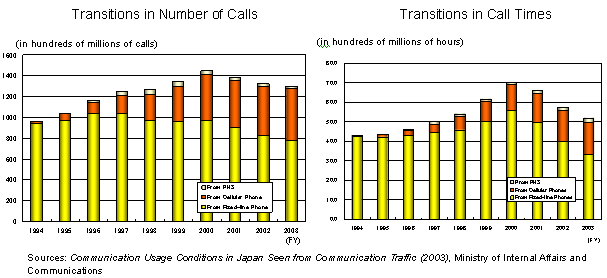
1.2 Growth of Broadband Services
1.2.1 The initial cause for this diminishing demand for fixed-line phones was thought to be migration to mobile communication services. In more recent years, however, the growth of broadband services has become the main factor in slumping fixed-line phones demand. The number of broadband subscribers is about 40%, when becoming 19 million or less as a whole, saying at the home joining rate. At the end of last year, ADSL service subscribers topped 13 million and are continuing to show an upward trend. Even more recently, the numbers of new subscribers to FTTH services have surged ahead at rates outstripping ADSL services. There were more than 2.4 million FTTH users at the end of last year. Moreover, the CATV Internet keeps increasing steadily, and almost three million subscribers exist. High-speed, inexpensive ADSL and FTTH broadband services are quickly gaining ground as they replace conventional dial-up Internet connections.Figure 3: Transitions in the Numbers of Broadband Subscribers
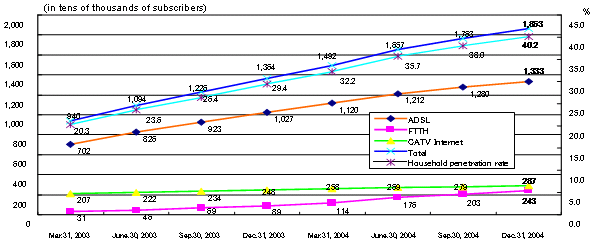
Sources: Broadband Subscriber and Other Market Transitions, Ministry of Internal Affairs and Communications, and other sources
1.2.2 In tandem with the proliferation of broadband services, the usage of IP telephony services, which are add-ons to broadband services, has risen spectacularly. The number of IP telephony users stood at 8.3 million at the end of March of this year and has outstripped the number of ISDN subscribers.
. .Table 1: Prices of Major IP Telephony Services
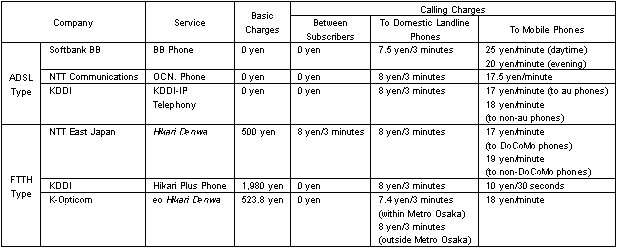
1.2.3 Another development has been the emergence of telephone services that bypass NTT switching equipment by utilizing NTT subscriber lines. By taking advantage of this mechanism, NTT's competitors are providing services with lower basic charges and calling charges than NTT.
Table 2: Comparison of Subscription Telephone Service Charges

1.2.4 The spread of these new services is a large factor in the drop in PSTN traffic mentioned in Section 1-1-2. More importantly, perhaps, these new services have altered the price structures of fixed telephone services. For instance, the introduction of flat-rate plans independent of the actual calling distance, typified by IP telephony, is making the detailed distance-dependent price structures of today's fixed telephone services meaningless. In fact, NTT itself introduced intra-prefecture flat-rate fixed telephone services this year. Thus, we are seeing definite movement to distance-independent fixed-charge services.
1.3 Cellular Phones
1.3.1 Focusing on mobile communication services, we find that mobile-phone users subscribing to Internet-connection services, such as i-mode, broke through the 75 million mark of all cellular phone subscribers 87 million at the end of March of this year. The ratio of the camera phone ownership reaches 76.3% of all cellular phone subscribers. We can conclude then that Internet-connection services are not only moving to broadband but going mobile as well.1.3.2 The package of the basic rental fixed amount including the free call becomes a main current in the voice call for the mobile phone charge system (The example: Ohanashi-plus of NTT DoCoMo). Moreover, the fixed amount service named Pake-Houdai, for instance, of the i-mode fixed amount service for the data communication, has come out, in addition to the usage based rate system for each packet.
Figure 4: Spread and upgrade of cellular phone
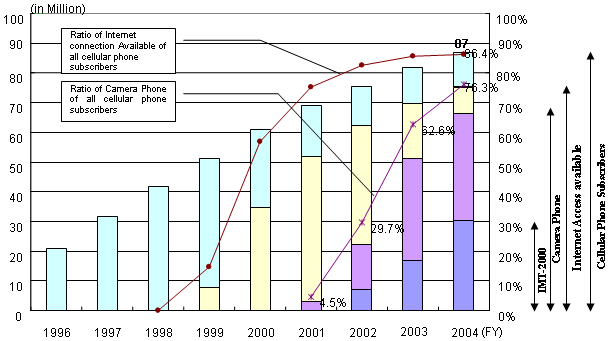
1.4 Diversification of Service Provision Conditions
De-tariffing has been spurred on by amendments to the Telecommunications Business Law. This has made it possible to provide services, other than universal telecommunication services, through bilateral contracts. It is increasingly common to offer services to corporate clients at cut-rate prices free of tariff based charges. As a result, the meaning of the comparison of the stipulation charges has weakened. As the administration, it is a difficult situation to understand information on these free charge settings.2 Price Baskets
2.1 National PSTN Basket
2.1.1 The existing national PSTN basket targets, in principle, only standard prices. The price basket is derived in consideration of a number of factors - number of calls per year, weighted distributions by distance steps and time slots, and call durations by time slots and distance steps. But due to the increasing influence of IP telephony and price-regulation reforms on fixed telephone services, the current calculation method will be no longer accurately reflecting actual price levels and losing its significance. Consequently, we believe eventually a much broader calculation method will need to be considered that does not include distance and time dependencies. Restricting ourselves to the problems at hand, however, we feel it is crucial to have the basket at least reflect accurately the diversification of price structures.2.1.2 Some other countries are also beginning to adopt fixed-charge-package prices for fixed-line phones, and in Japan discounted pricing has become widespread. For instance, about 20% of the subscriber is using Ichi-Rittsu of the call charge discount of NTT East. We think that it is preferable to apply the discount rate spread generally like this, which everyone can use, to the basket. When the charge basket is reexamined, it is our hope the secretariat will try to understand the realities in each country in the effective charge for reflecting not the standard fee but various discounts and the fixed charge system prices.
2.2 Broadband and VoIP Price Basket
2.2.1 As described above, broadband services and VoIP are expected to form the core of telecommunication services in the near future. Japan is extremely interested in a price comparison of these services. We are aware these services have become prevalent in other OECD member countries as well. Additionally, the ITU and OECD are already undertaking comparisons of broadband prices. It is necessary to always review the today's special of the object of comparison in an evolving broadband market, and it is necessary to compare advanced service in addition to the main service of each market.Figure 5: OECD's International Comparison of Broadband Prices
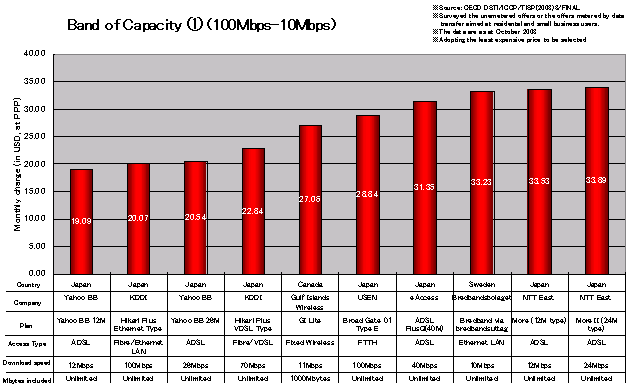
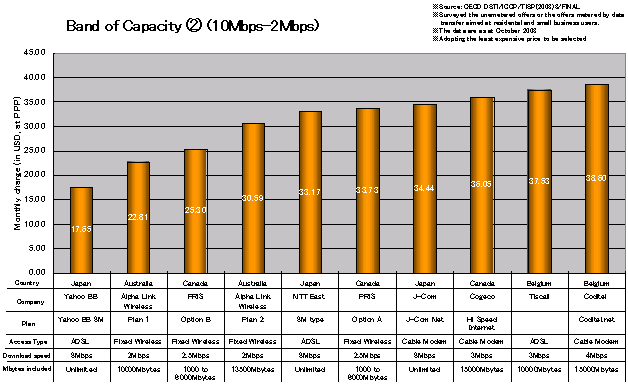

Figure 6: ITU's International Comparison of Broadband Prices
Broadband charge for each amount 100kbps of data transmission
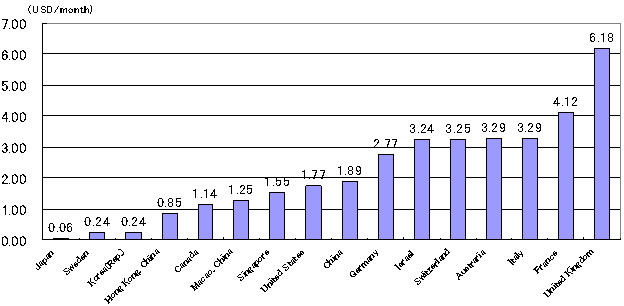

2.2.2 Of broadband services, we understand ADSL services - services provided over the same metal line (line sharing) as telephone services - are generally bundled with telephone services. For example, one of the benchmarks in the e-Japan Priority Policy Program 2004, the Japanese government's IT strategy roadmap, was an international comparison based on the sum of basic telephone charges + ADSL communication charges + Internet access fees. Thus, we believe it is reasonable to combine telephone and ADSL services in one price basket.
Figure 7: International Comparison of Broadband Prices from the e-Japan Priority Policy Program 2004

2.2.3 FTTH services, on the other hand, are not offered together with telephone services as ADSL services are. Instead, FTTH services are promising to develop into an alternative to fixed telephone services. Hence, there is little relevance or necessity to compare FTTH service prices in the same basket as telephone services. Rather, we think it is appropriate to construct an independent basket for FTTH prices.
2.2.4 VoIP services take many forms, such as PC-to-PC Internet telephony or services only using IP technology over relay lines. In price comparisons, however, it is apt to compare those VoIP services provided by telecoms as part of end-to-end IP broadband services. VoIP services of this nature are normally offered as an option or an additional service to ADSL or FTTH services. The idea taking VoIP costs as bundled with the broadband service should be suggested for the price-comparison methodology, not taking the VoIP communication costs alone. A fair comparison method should be selected after considering the VoIP situations in member countries.
2.2.5 In broadband service, it is appropriate to compare prices by the charge for each data transmission speed because there is an enormous discrepancy by the transmission rate.
2.3 National Leased-Line Basket
2.3.1 Competition is developing in the leased-line business in many countries and large price variations are anticipated caused by differences in service quality and support (maintenance) options. In Japan too, many of companies supply leased-line services with different levels of support. Moreover, the one to have decided the charge by the negotiated transaction with the entrepreneur increases for a business user. In that case, it is discounted more greatly than the tariff of charges.The leased-line shifts to more high-speed service and to the service of the IP-based system. Therefore, in the charge comparison in the leased-line basket, stopping the comparison by the legacy and old service, and comparing the service that is newly becoming a main current are suitable in the near future.
Figure 8: Price Comparison Based on Maintenance Options
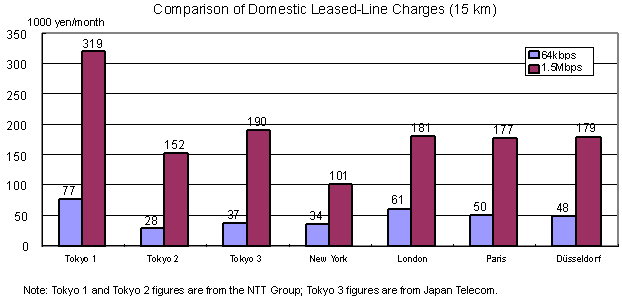

2.3.2 It also appears that no leased-line prices are released in some countries; all prices are set by individual contracts. It is believed that individual contracts introduce large differentials in price levels according to the number of contracted lines. Although we feel that special individual factors should be excluded whenever possible to arrive at a fair price comparison between countries, leaving out countries where leased-line charges are not publicized would make any price comparison meaningless given the prospects for further de-tariffing of leased lines.
2.3.3 Consequently, we suggest that the applicable prices for the leased-line basket be selected on the following criteria: (1) in terms of support levels, use the simplest leased-line service with as few support options as possible; (2) in terms of applicable prices, either use the appropriate price with such support level as described in (1) above where price tables are publicized or use the most popular price of the applicable carrier where price tables are not publicized; and (3) use the most inexpensive price of the top three firms providing leased-line services nationwide.
2.4 Mobile Basket
2.4.1 The basket for mobile telecommunication services represents the cheapest available package in each country and employs discounted prices with restrictions on contract length such as multiple-year contracts in other countries. Nevertheless, the basket does not consider plans that give discounts through multiple-year contracts despite the fact that these plans are common in Japan. We would like to request when OECD selects price plans for the mobile basket that it employ the cheapest available package.For example, we suggest using Ohanashi Plus-S for users with low usage profiles and Ohanashi Plus-BIG for users with high usage profiles and then employing the prices discounted through multiple-year contracts for each of these plans.
2.4.2 It is necessary to clarify the difference between prepaid and postpaid.
2.4.3 The current mobile basket underestimates prices in countries where the receiving party pays a portion of mobile call fees because the price to the calling party per call is discounted by the amount the receiving party pays. This results in an unfair comparison with countries where the calling party is responsible for the total call charge. We feel some modifications to the mobile basket should be made, such as doubling calling-party prices in RPP countries (assuming the amount of traffic received by mobile phones is roughly the same as the amount of traffic initiated from mobile phones).
2.4.4 As mentioned previously, the use of mobile phones for data communications and MMS is quite advanced in Japan. MMS is also used extensively in European countries. In view of these circumstances, a comparison of these prices would be relevant. Since MMS - one communication mode of a mobile phone - is used in combination with voice communications, we think it should be incorporated in the mobile basket in the same way as SMS currently is.
2.4.5 When it comes to data communications, Internet access from mobile phones is not yet prevalent in Europe and the Americas. Therefore, we think it is important to first ascertain each country's usage configurations before determining whether mobile data communications should be included in the mobile basket or if it is better to form a separate basket. At present, supposing the comparison is put into practice, since data communications are usually billed under fixed-charge schemes, we can conceive of a possible comparison involving prices, for example, for unrestricted use or for 50 Mbytes or more per month.
2.4.6 The monthly sum fixed charge system that sets the voice and the data communication appears for the mobile phone, too. In view of new services going out, it is necessary to review the basket flexibly always.